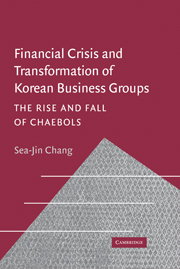Book contents
- Frontmatter
- Contents
- Preface
- 1 Introduction
- 2 The Evolution of Chaebols
- 3 Chaebols' Diversified Business Structure
- 4 Vertical Integration of Chaebols
- 5 The Capital Structure of Chaebols
- 6 Chaebols' Ownership and Governance Structure
- 7 The Restructuring of Chaebols
- 8 Conclusion
- Appendixes
- Notes
- References
- Index
- References
References
Published online by Cambridge University Press: 05 January 2010
- Frontmatter
- Contents
- Preface
- 1 Introduction
- 2 The Evolution of Chaebols
- 3 Chaebols' Diversified Business Structure
- 4 Vertical Integration of Chaebols
- 5 The Capital Structure of Chaebols
- 6 Chaebols' Ownership and Governance Structure
- 7 The Restructuring of Chaebols
- 8 Conclusion
- Appendixes
- Notes
- References
- Index
- References
Summary

- Type
- Chapter
- Information
- Financial Crisis and Transformation of Korean Business GroupsThe Rise and Fall of Chaebols, pp. 327 - 344Publisher: Cambridge University PressPrint publication year: 2003

